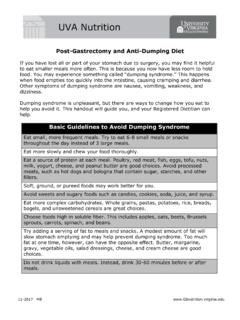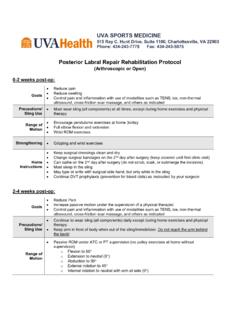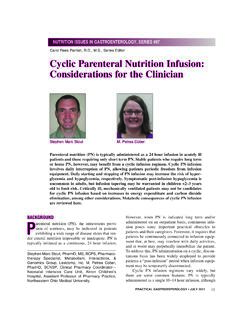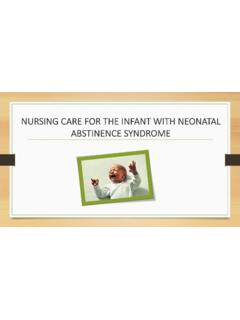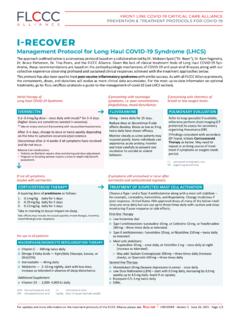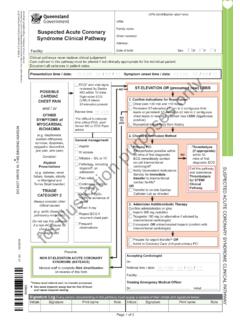Transcription of Propofol-Related Infusion Syndrome
1 PRACTICAL GASTROENTEROLOGY JANUARY 201016 Propofol-Related Infusion SyndromeINTRODUCTIONP ropofol-related Infusion Syndrome (PRIS) is a rareyet often fatal Syndrome . It is described as acutebradycardia progressing to asystole combined withlipemia, severe metabolic acidosis (often with baseexcess less than 10 mEq/L), rhabdomyolysis or myo-globinuria associated with the continuous Infusion ofpropofol, regardless of the duration (1). The syndromewas originally described in the literature in the early1990s in children receiving propofol at high doses (>4 mg/kg/hour) for long-term sedation (>48 hours).
2 Most of these patients developed severe metabolic aci-dosis, rhabdomyolysis, acute renal failure, progressivecardiac failure, with a high mortality rate (see Table 1).Based on these findings, the Food and Drug Adminis-tration (FDA) issued warnings against propofol s use inpediatric patients (2). Although originally thought to bea problem related to use in children, reports of deathsassociated with propofol use in adults appeared in theliterature beginning in the late 1990s (2). According toNUTRITION ISSUES IN GASTROENTEROLOGY, SERIES #81 Leigh Ann Mike, , BCPS, Clinical AssistantProfessor, University of Washington School of Phar-macy and Clinical Pharmacist, Critical Care, Har-borview Medical Center, Department of Pharmacy,Seattle, Infusion Syndrome (PRIS) is a rare yet often fatal Syndrome that hasbeen observed in critically ill patients receiving propofol for sedation.
3 PRIS is charac-terized by severe unexplained metabolic acidosis, arrhythmias, acute renal failure,rhabdomyolysis, hyperkalemia, and cardiovascular collapse. Although the exact patho-physiology of PRIS remains to be determined, impaired tissue metabolism caused bypropofol Infusion appears to be an important mechanism leading to complete cardio-vascular collapse. Risk factors for developing PRIS include sepsis, severe cerebralinjury, and high propofol doses. Early recognition of the manifestations is the key tomanaging PRIS. If PRIS is suspected, propofol should be discontinued and an alterna-tive sedative agent initiated.
4 General measures to support cardiac and renal functionshould be initiated promptly in patients with suspected PRIS. Carol Rees Parrish, , , Series EditorLeigh Ann Mike(continued on page 19)these case reports, the clinical presentation of PRIS inadults appeared very similar to those reported in thepediatric population. FORMULATION AND CLINICAL PHARMACOLOGYOF PROPOFOLP ropofol is an intravenous short-acting sedative hyp-notic agent that has been in use for over two decades(3). It has a rapid onset of action (within seconds) anda very short half-life. It was initially used as an induc-ing agent for general anesthesia.
5 Because of its favor-able pharmacokinetic and pharmacodynamic profiles,it later became widely used for sedation in intensivecare units. The pharmacokinetic properties of propofolmake it an attractive option for sedation of intubated,mechanically ventilated patients in intensive care short onset of action and half-life allows for rapidawakening once the Infusion is discontinued. It can alsobe easily titrated to maintain the desired level of seda-tion in critically ill patients. In addition, propofol israpidly deactived via a conjugation reaction both hepat-ically and extra-hepatically.
6 The non-renal, non-hepaticdependent metabolic clearance makes it a superiorsedative agent over benzodiazepines or opioids for ICUpatients with end organ failure, especially from a safetyperspective. In addition to its sedative and amnesiaeffects, propofol also decreases cerebral oxygen con-sumption and reduces intracranial pressure. It alsoshows excellent antiepileptic activities with provenefficacy in treating patients with refractory characteristics have further expanded the use ofpropofol beyond its initial approved indication as asedative for induction and maintenance of is a highly lipophilic compound and isessentially insoluble in water or other aqueousmedium.
7 Therefore, it is formulated as an intravenousemulsion with 10% lipid (1 mL contains kcal; fat) containing soybean oil and egg lecithin so thatthe lipid component is used as a carrier for the of this, Infusion of propofol at a high rate oras a large bolus may lead to lipid intolerance. Simi-larly, the presence of lipid emulsion also causes con-cern for sterility and the risk of contamination bybacteria and fungi. Therefore, tubing and open vials ofpropofol should be replaced every twelve hours (3).The common side effects of propofol include pain oninjection, hypotension, bradycardia, decreased cardiacoutput, hyperlipemia, and hypertriglyceridemia.
8 INCIDENCE Because the definition of PRIS has not been standard-ized, the exact incidence of propofol Infusion syndromeis unclear. In addition, no longitudinal investigations orpatient registry designed to determine the incidence ofPRIS exists. Therefore, the information available isbased solely on case reports published over the last twodecades. The reported incidence varies depending onwhich symptoms were being considered and provided ineach case report. For instance, using metabolic acidosiswith no other apparent causes as the primary criterion,Cravens and colleagues reported that 24% of patientsreceiving propofol during radiofrequency ablationdeveloped PRIS (4).
9 Compared with other reports, theincidence is unusually high in this study because theinvestigators used base excess ( 2 mEq/L or less) as thecase definition. On the other hand, using unexplainedacidosis, creatine kinase elevation unrelated to trauma,and electrocardiographic changes as criteria in patientswith severe head trauma, Smith and colleagues reporteda 6% incidence of PRIS (5). Using the FDA MED-WATCH Adverse Event Reporting System databasebetween 1989 and 2005, and applying symptoms basedon all the published case reports as clinical criteria,PRACTICAL GASTROENTEROLOGY JANUARY 201019 NUTRITION ISSUES IN GASTROENTEROLOGY, SERIES #81 Propofol-Related Infusion Syndrome (continued from page 16)Table 1.
10 Clinical Features of Propofol-Related Infusion Syndrome Metabolic Acidosis Arrhythmias Lipemia Hepatomegaly Rhabodomyolysis Acute Renal Failure Hyperkalemia Progressive Myocardial Failure Cardiovascular CollapsePRACTICAL GASTROENTEROLOGY JANUARY 201020 NUTRITION ISSUES IN GASTROENTEROLOGY, SERIES #81 Propofol-Related Infusion SyndromeFong and his colleagues identified 1,139 cases of PRIS over a period of 17 years (6). Therefore, the actual inci-dence remains to be determined but appears to be veryinfrequent. Nevertheless, the mortality rate among these1,139 cases was 30%.
